

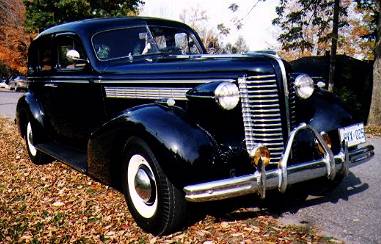
|
In 1867, a young Irish emigrant in Tyrone, Ontario, Canada, lived on a farm he had cleared using an axe with a handle he had made himself. The farmer's axe handles brought a good price at the market in Bowmanville, but eventually he wanted to apply his skills to a bigger project. After carefully studying pictures in an old carriage catalog, he made up his mind to build himself a horse-drawn sleigh.
"One Grade Only And That The Best"

|
As the farmer, Robert McLaughlin, worked on his project, a neighbor asked if he could buy the finished sleigh. The farmer offered to make another just like it. He agreed to a delivery date, but the traveling blacksmith to whom he assigned the ironwork arrived late, and the farmer had to work day and night to finish the sleigh and keep his promise. The farmer subsequently added his own blacksmith shop to his farm operation. In a short time, it was a thriving business. McLaughlin's motto was "One grade only and that the best". In 1878, McLaughlin moved the operation to Oshawa, Ontario and began a carriage plant. Oshawa had train connections and was closer to banking and other business. McLaughlin took over an old furniture factory in Oshawa which at the time was said to be too big. Within a couple of years this was proved wrong. McLaughlin sleighs and carriages were of the best quality and construction and orders poured in so fast that additional facilities were started across Ontario.
From Carriages to Motor Cars
Robert McLaughlin had three sons. The oldest son, John J. McLaughlin, went on to become a chemist; he went to Toronto and established the Canada Dry company there. The other two sons, R.S. "Sam" and George, became partners in the McLaughlin Carriage Company. In December 1899 disaster struck. The plant burned to the ground along with everything inside. The McLaughlins were down but not out. With financial help from the city of Oshawa, the plant was rebuilt.
In 1901, Sam and George went for a ride in the company bookkeeper's automobile. The brothers raced back home, very excited, and tried to persuade their father into making a horseless carriage. Robert dismissed the idea stating the vehicles were noisy and dangerous and just a passing fad. In 1905, Sam test-drove several motor cars and decided the Buick was the most well designed car. Sam began plans for manufacturing Buick cars in Canada. He nearly came to a manufacturing agreement with an old friend in the United States -- Billy Durant, a partner in the Buick Motor Company -- but the deal fell apart over the financial arrangements. Back at home, Sam and George finally got father Robert to agree to a plan to form the McLaughlin Motor Car Company.
Production was about to begin when the engineer fell seriously ill. After some hesitation, Sam sent a telegram to Durant and asked to borrow an engineer. The next day Durant arrived with two Buick executives, the original plans for collaboration were resurrected, and in 1908 the plant turned out 154 cars -- called McLaughlins -- with Buick engines.
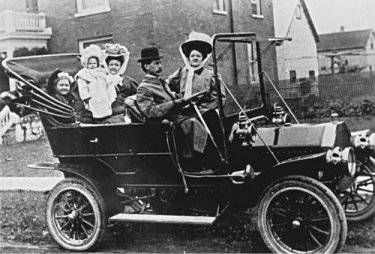
Click here for an enlarged image. |
McLaughlin Cars Earn a Reputation for Quality
Canada was fond of its McLaughlin but sales declined after the first year of production. After a Buick won the first race at the Indianapolis Speedway in the United States, the McLaughlin's advertising men wanted to cash in on the elaborate Buick advertising campaign by changing the name to Buick. William Durant also wanted to change the name to Buick, but the McLaughlins said no. When sales began to decline further, the name McLaughlin-Buick was agreed upon.
In 1908, Durant had assembled Buick and Oldsmobile into General Motors, but by 1910 he had overreached himself and was ousted from his company by alarmed bankers. Undaunted, he started a new venture with Louis Chevrolet, a former Buick racing driver from Switzerland. The popularity of the new car, christened the Chevrolet, grew so fast that by 1915 Durant's Chevrolet shares were worth enough that he could regain control of GM.
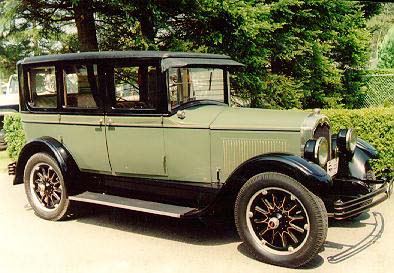
|
Durant planned to build a Chevrolet plant in Toronto, and the McLaughlins were worried about competition with the Buick. One day while visiting New York, at lunch with Durant and a Chevrolet stockholder, Sam casually asked how the Canadian project was going. "Why don't you give it to the McLaughlin boys, Billy?" piped in the stockholder. "Well, Sam, do you want it?" asked Durant. In two days Durant and the McLaughlins had reached a deal. Robert McLaughlin -- still not entirely convinced that the era of horse-drawn carriages was almost over -- reluctantly agreed to the sale of his carriage business to make way for production of Chevrolets alongside Buicks at the Oshawa plant. As with the McLaughlin-Buicks, the Canadian-built Chevrolets had special appeal. Their bodies were made to Sam McLaughlin's designs, and the McLaughlin plant applied a superior finish. On seeing a McLaughlin-Buick left standing outside General Motors' New York office, an envious GM executive ordered it sent home: "It's gathering crowds -- and it's no more like one of our Buicks than a St. Bernard is like a dachshund!"
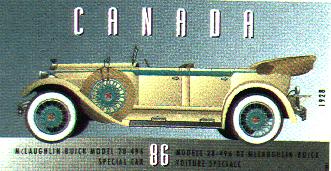
|
A Family Business Becomes General Motors of Canada
The McLaughlins' Chevrolets were as much of a success in Canada as Chevrolets were in the United States. By 1918, though, neither George nor Sam had sons interested in carrying on the business. In a five-minute meeting, GM management agreed to buy the McLaughlin business, but on one condition -- that the McLaughlins stay to run it. Delighted with the vote of confidence, Sam and George became the first president and vice president of General Motors of Canada. Sam remained president until 1945. When he died in 1972, at the age of 100, he was still chairman of the board. Under his guidance, General Motors of Canada enjoyed tremendous growth and became a major contributor to GM's total production.

|
William Durant - Friend of the McLaughlins
William Durant resigned from General Motors in 1920 and started Durant Motors. A major figure in the bull market of the '20s, Durant had amassed a $50-million fortune by 1927. When the crash came in '29, Durant was hit hard. In 1933, Durant Motors went broke. In 1936, William Durant filed in bankruptcy and suffered a massive stroke in 1942. He and his wife moved to New York, where they lived quietly, supported not by the General Motors he had created, but by long-time associate R.S. McLaughlin. Durant died in New York in 1947.
Parkwood Estate
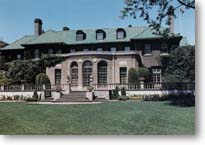
|
When R.S. "Sam" McLaughlin and his wife, Adelaide, decided to construct a family home in 1915, they gathered some of the best known architects, landscape designers, artists and craftsmen to create an estate so resplendent, that even 80 years later, visitors stare in awe at its beauty, both inside and in the exotic gardens that grace the 12-acre site. The mansion is called Parkwood Estate and has 55 rooms.
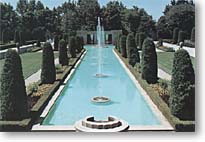
|
Not content to live in a "typical" estate home, R. S. McLaughlin incorporated some extremely innovative inventions into the impressive home. Ever wonder about the first automatic bowling lane pinsetters? Parkwood sports one of the first made in North America on its private bowling lane. And can you believe that a central vacuum system made cleaning easier in the grand home back then? An indoor pool and squash court were also lavish luxuries the McLaughlins enjoyed at Parkwood for years.
When Sam died in 1972 he willed the house and grounds to Oshawa hospital. They in turn kept it as one of Canada's finest homes and it is open to the public for anyone to visit. Administrated by the Parkwood Foundation, the estate is maintained in its original state, complete with furnishings, carpeting, draperies, paintings, and family photos donated by Mr. McLaughlin's five daughters.
The estate has become one of the most popular movie film sites in Canada. During the past decade, dozens of feature films and television episodes have been shot at the spectacular mansion. Among the feature films are "The Ref" and "Billy Madison".
Robert McLaughlin Art Gallery

|
Many of Oshawa's cultural facilities and attractions stem from the interests of the

|
In 1967, C. Ewart McLaughlin, grandson of Robert McLaughlin - the McLaughlin Carriage Company's founder, provided funds for the gallery's first building. In 1987, an expanded building opened with 11,000 additional space. The new facility was also enhanced by an important gift from Isabel McLaughlin, the well known artist/patron granddaughter of Robert McLaughlin for whom the gallery is named. Isabel donated an outstanding collection of Canadian, international, and native art.
GM of Canada Today
Today GM of Canada produces more than one million vehicles a year. 85% of those vehicles are sold to the United States. GM is Canada's largest manufacturer of automobiles and automobile components. In the 1980s, GM began an $8 billion reindustrialization program creating the GM Autoplex in Oshawa. This facility employs over 13,000 men and women and is the largest and most modern vehicle manufacturing complex in North America.
And to think it all started in a small barn owned by a farmer named Robert McLaughlin who wanted to apply his woodworking skills to a bigger project.